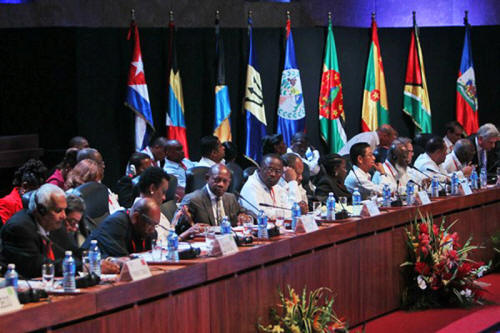|
recovered through Google-WebCache Website
PDF version of Google-WebCache
Caribbean leaders meet during the Summit Cuba-Caricom, Havana, Cuba, Dec 8, 2014 (AP photo by Ismael Francisco).
Just when the United States seems to be retreating from competition in global markets, and possibly even NAFTA, socialist Cuba is moving in the opposite direction.
With the
signing late last month of a
new trade agreement with the 15 countries of the Caribbean
Community, or CARICOM, Cuba is looking to capitalize on trade and
economic links with its neighbors.
The Caribbean countries have begun to see
Cuba in a different light following the start of the normalization
of relations between Havana and Washington and the prospect of the
U.S. lifting, or at least relaxing, its Cuban embargo. Instead of
their old view of Cuba as a threat, Caribbean countries are coming
around to
seeing the country as an economic opportunity.
For the first time since the revolution, Cuba has a chance to achieve its economic potential and become a significant force throughout the region. The absence of a major international patron is forcing the Cuban government to confront the country's long-standing economic malaise with a market-oriented reform program.
In turn, the relaxation of U.S.
restrictions, Havana hopes, will allow Cuba to grow its economy by
shifting resources toward its areas of comparative advantage, such
as tourism.
Predictably, the result was an extremely inefficient economy, one where social progress could advance much faster than the economic base.
This pattern of
unbalanced development has left Cuba extremely vulnerable to
economic and political conditions in its partner countries - most
evident in the economic crisis of the 1990s, after the collapse of
the Soviet Union.
But more recently, trouble in places like Brazil, which has provided key assistance to Cuba, has hurt one of Cuba's major hard currency earners, the medical service export industry.
Cuban doctors and nurses have a long history of working abroad, but since the industry is highly dependent on government-to-government contracts rather than market forces, it has experienced extreme volatility.
In 2013, Brazilian President Dilma Rousseff suspended a deal for more than 5,000 Cuban doctors to work in Brazil.
Following Rousseff's impeachment last
year, the interim government of President Michel Temer quickly
announced a major revision of the agreement that will ultimately
result in a
significant reduction of Cuban doctors and nurses participating
in Brazil's "more doctors" social program.
They are meant to provide a foundation for the creation of a new private business sector - an important first step toward the creation of a market-based economy.
Many of the new private-sector firms are potential exporters, but low labor productivity, international competitiveness and export capacity have seriously lagged. Government red tape, poor infrastructure and the lack of supply chains all contribute to stagnant productivity in Cuba.
More importantly, there is
not enough competition in the domestic market to force firms to
use resources efficiently.
CARICOM member states have also agreed to grant duty-free access to Cuban goods, such as pharmaceuticals.
Based on the theory
of the "new
economic geography" - in which companies essentially want to move
their operations from Asia closer to their Western markets - once
established in the larger CARICOM market, it would be much easier
for Cuban and other Caribbean firms to export to the U.S. and other
countries than attempting this transition in one giant step.
Cuba could
end up attracting many of the tourists who previously visited other
island destinations. But a dynamic Cuban economy that provides new
trade and investment channels is still a major opportunity for small
island nations long plagued with low growth rates and excessive
levels of debt.
Affluent travelers to the British and U.S. Virgins Islands, Barbados and the Bahamas may be attracted more to Cuba for its unique culture, terrain and history.
But travelers priced out of Cuba,
which remains expensive for tourists, will simply go elsewhere, as
they always have.
But Dominican authorities
and businessmen see a Cuba that is opening up as an opportunity;
negotiations
are expected on a bilateral commercial agreement.
A growing Cuba will help the Caribbean as a whole become more attractive to foreign investors looking to establish supply chains linking Central America and the Caribbean to the United States.
It is easy to see a virtuous
circle of growth and further reforms taking hold, which has been a
cornerstone of U.S. trade policy.
That was a
safe bet when most people expected Hillary Clinton to be president.
He has promised at different times to roll back former President Barack Obama's measures, or at least demand "a better deal" from Cuba. So far, there have been no details of what that "better deal" would be.
It isn't just Havana
that is worried, but its Caribbean neighbors, who have a lot on the
line...
|


